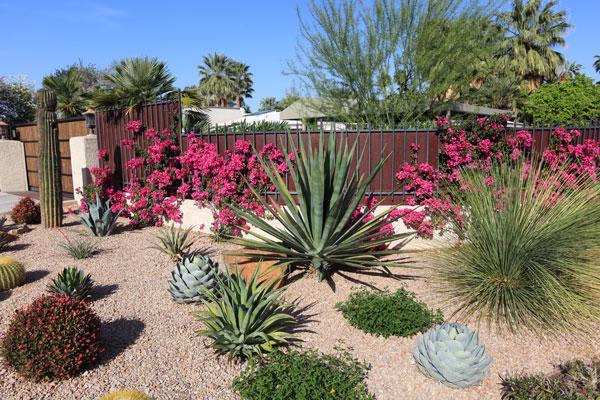In a sustainability-conscious and water-saving culture, more people are choosing to “xeriscape” and opt out of traditional lawns that require more resources. Read on to learn about xeriscaping and how it can beautify your lawn with water-wise plants.
What Is Xeriscaping?
Xeriscaping is landscaping with slow-growing, drought-tolerant plants that require minimal watering.
Xeriscaping is great because it takes advantage of the ability of water-wise plants to conserve water. Plus, choosing less-thirsty plants means your lawn or garden will still look great in times of drought. Xeriscaping with water-wise plants also reduces trimmings that create waste and it requires less effort to maintain. But it’s not all just about the plants you choose; xeriscaping considers the entire lawn or garden system, including soil type, layout and planting time, to make the smartest use of water.
What Are the Benefits of Choosing Water-Wise Plants in Yard Planning?
The pros of landscaping with water-wise plants are threefold:
- It saves you money
- It reduces labor and waste
- It helps preserve the environment
With xeriscaping, it’s easy to see how everything is connected. Xeriscaped spaces require minimal watering and smaller amounts of fertilizer and pest control, so they reduce your water bill and save you money. This in turn saves you the labor that comes with watering and upkeep of a more demanding lawn and results in less (or no) trimmings to pick up and eliminate.
Finally, xeriscaping preserves the environment because cutting back on pesticides and fertilizers prevents them from entering the water supply and atmosphere, conserving water allows us to preserve it for other and/or future use and eliminating clippings decreases the waste that ends up in landfills.
In all these ways, xeriscaping creates a domino-effect that results in the public good.
How Do I Get Started Xeriscaping with Water-Wise Plants?
To get going on your xeriscaped space, remember that California is a diverse place where resources vary. Ask yourself what specific characteristics make up your lawn or garden space.
Think Water, Soils and Sunlight
Research the type of soil you have underfoot. Well-drained soils, which can absorb half an inch of water or more per hour, are ideal and make plenty of nutrients available for plants. However, soils that drain too well may need help to better hold water for plants. In these cases, it’s possible to enhance soils by adding amendments to enhance effectiveness. Consider having your soils tested for organic materials and enhanced if necessary.
Finally, consider the sunlight and shade in your specific lawn or garden space. For example, the house will provide shade along the eastern wall in the afternoon. Consider plants that will accommodate and thrive under these specific conditions.
Choose Water-Wise Plants that Meet Specific Needs
Once you have a good understanding of the conditions that surround you, select plants that accommodate the water, soil and sunlight of your unique space. Any plant that is suitable for the environment will work, so there’s no need to limit yourself to California natives (though they make an easy place to start your search for water-wise plants). For specifics, you can check out the San Jose Water (SJW) website, which will give you the rundown on water-wise plants.
Combine Water-Wise Plants with a Layout that Makes Good Sense
When you know the plants you want to use, it’s time to plan a garden or lawn layout that makes the best use of the space. Front and backyard templates and resources are available online to help you get started with water-wise lawn layouts.
Group plants with similar needs that consider your privacy, safety and accommodations for children’s playscapes.
If an irrigation system makes sense for the needs of your water-wise plants and layout, consider a drip system that allows water to slowly trickle out in moderation, reducing the likelihood of runoff and water waste.
Where Do I Look for More Information on Water-Wise Plants?
With a detailed plan, you’ll be well on your way to xeriscaping a beautiful space. Check out the SJW page for more on water-wise gardening and download the Drought-Savvy California Garden Designs eBook.

